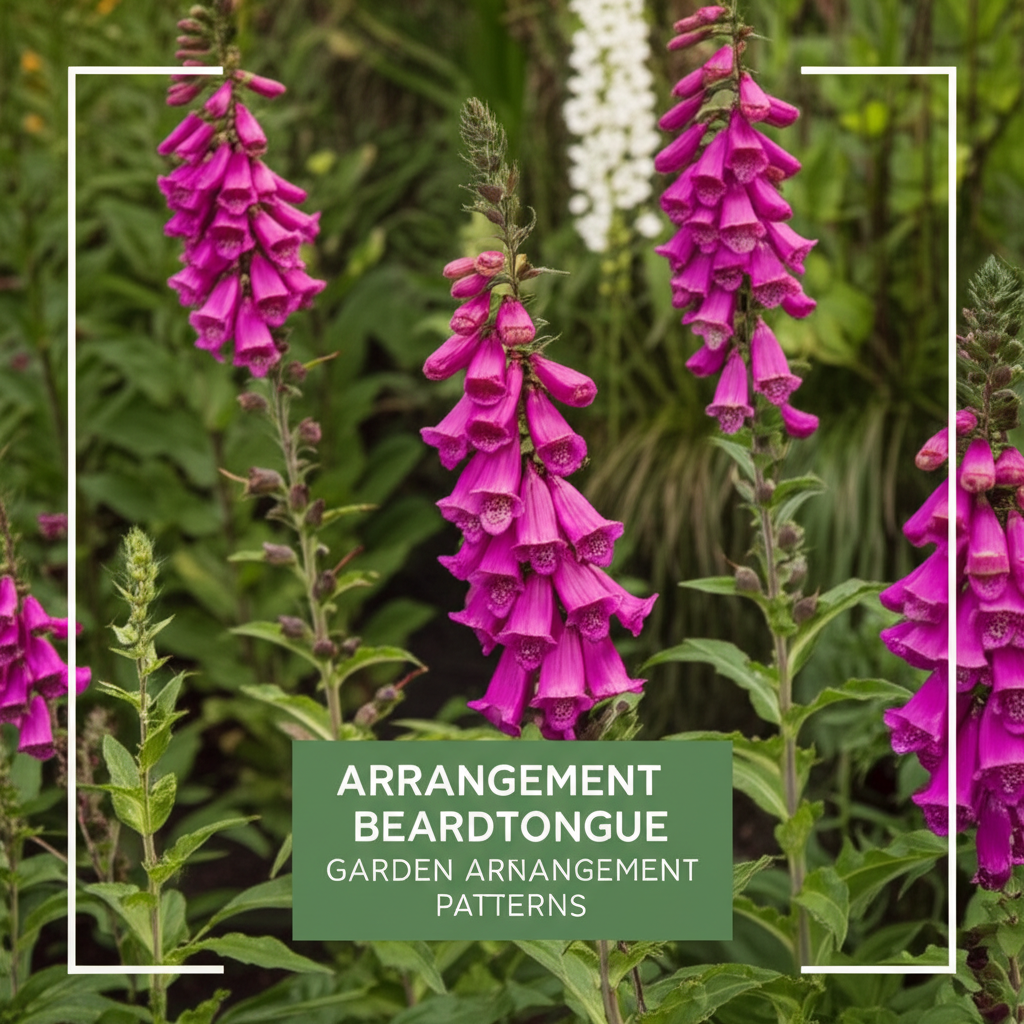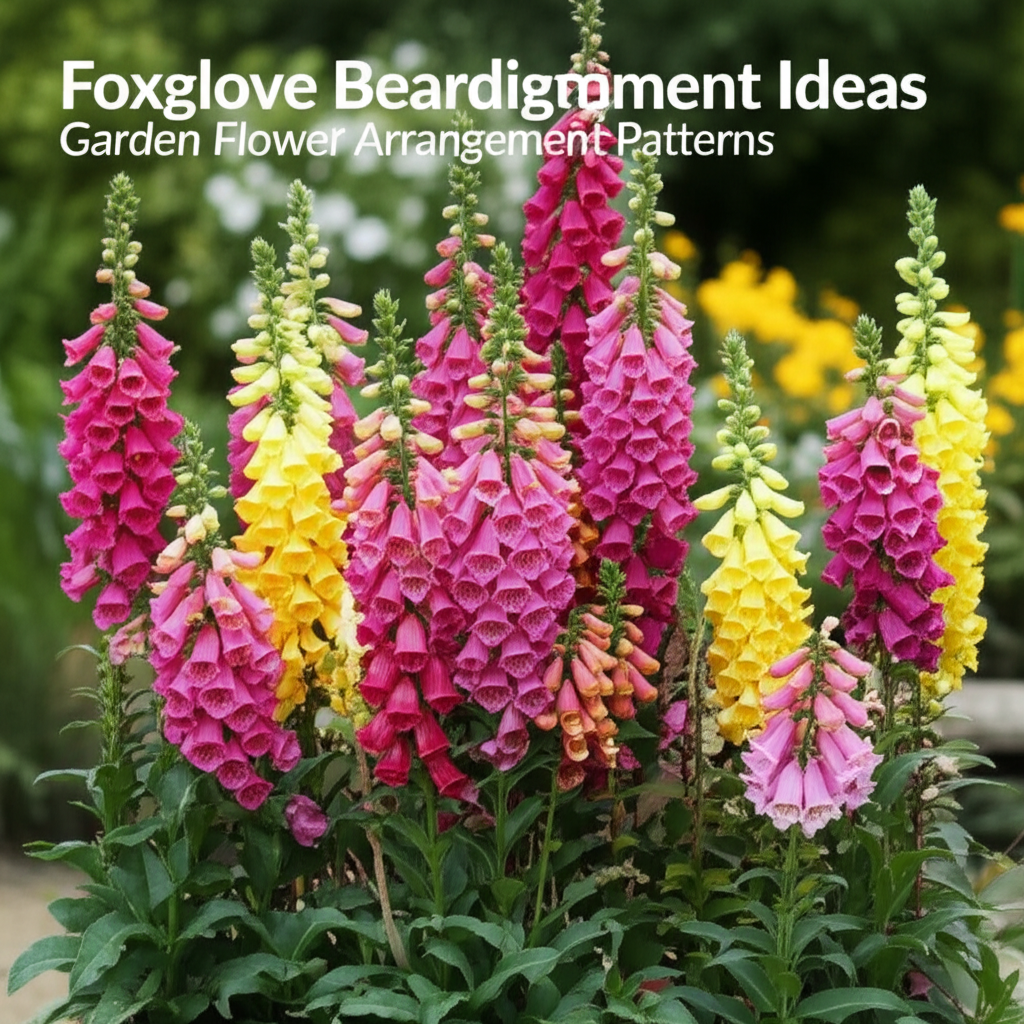Introduction to Foxglove Beardtongue (Penstemon digitalis)
Foxglove Beardtongue, scientifically known as Penstemon digitalis, is a captivating native perennial that brings both beauty and ecological value to any garden. Its tall, spiky blooms, typically a soft white to pale pink, emerge in late spring to early summer, attracting a host of pollinators like bees, butterflies, and hummingbirds. Unlike its more common but toxic namesake, the true Foxglove (Digitalis purpurea), Penstemon digitalis is non-toxic and offers a robust, adaptable addition to a wide range of garden designs. This guide explores various garden arrangement patterns that showcase the unique charm and versatility of Foxglove Beardtongue, providing inspiration for both novice and experienced gardeners.
Understanding the Appeal of Foxglove Beardtongue
The appeal of Foxglove Beardtongue lies in its architectural form, long blooming period, and its beneficial role in supporting local ecosystems. Its upright flower stalks create a strong vertical element, contrasting beautifully with mounding or spreading perennials and groundcovers. The tubular flowers are perfectly shaped to welcome long-tongued pollinators, making it a star player in a pollinator-friendly garden. Furthermore, its tolerance for a variety of soil conditions, including moist to average soils, and its preference for full sun to partial shade, make it a relatively easy-to-grow and low-maintenance plant.
Key Facts About Foxglove Beardtongue

To effectively incorporate Foxglove Beardtongue into garden designs, understanding its key characteristics is essential. This table provides a quick overview of its vital statistics.
| Attribute | Detail |
|---|---|
| Scientific Name | Penstemon digitalis |
| Common Names | Foxglove Beardtongue, Smooth Beardtongue, White Beardtongue |
| Plant Type | Perennial Herb |
| Native Range | Eastern and Central North America |
| Bloom Time | Late Spring to Early Summer (May-June, sometimes into July) |
| Flower Color | White to pale pink, often with subtle purple veining |
| Height | 2-4 feet (60-120 cm) |
| Spread | 1-2 feet (30-60 cm) |
| Sun Exposure | Full Sun to Partial Shade |
| Soil Preference | Moist to average, well-drained soils. Tolerates clay and sandy soils. |
| Drought Tolerance | Moderate once established |
| Hardiness Zones | 3-8 |
| Pollinator Attraction | High (bees, butterflies, hummingbirds) |
| Toxicity | Non-toxic |
Arrangement Patterns for Foxglove Beardtongue
Foxglove Beardtongue’s vertical growth habit and elegant blooms lend themselves to a variety of impactful garden arrangements. Whether you are designing a formal border, a wild meadow, or a pollinator-focused sanctuary, this plant can be a foundational element.
1. The Vertical Accent in Mixed Borders
One of the most effective ways to utilize Foxglove Beardtongue is as a vertical accent within a mixed perennial border. Its height provides a visual anchor and draws the eye upwards, adding depth and dimension to the planting.
Key Principles for Border Design:
- Placement: Position plants towards the back or middle of the border, depending on its width, ensuring they don’t overshadow shorter plants in the foreground.
- Grouping: Plant in groups of three or more for a more impactful display. A drift of five to seven plants can create a stunning visual statement.
- Color Harmony: Pair Foxglove Beardtongue with plants that complement its white to pale pink blooms. Consider cool colors like blues, purples, and silvers, or warmer tones like soft yellows and peaches.
Companion Plants for Borders:
- Blue and Purple Tones: Catmint (Nepeta), Coneflower (Echinacea), Salvia varieties, Veronica.
- Soft Yellows and Whites: Yarrow (Achillea), Coreopsis, Shasta Daisy (Leucanthemum).
- Foliage Interest: Hostas with blue-green or silver foliage, ornamental grasses like Feather Reed Grass (Calamagrostis x acutiflora ‘Karl Foerster’) for contrasting vertical lines.
2. Meadow and Prairie Style Planting
Foxglove Beardtongue is a natural fit for meadow and prairie-style gardens, thriving in conditions that mimic its native habitat. Its airy form and long bloom time contribute to a natural, flowing aesthetic.
Achieving a Natural Look:
- Drifts and Waves: Plant in naturalistic drifts, mimicking how plants would appear in a wild setting. Avoid rigid lines or formal patterns.
- Intermingling: Allow Foxglove Beardtongue to weave through other meadow plants like Asters, Goldenrods, and native grasses.
- Successional Bloom: Combine it with early, mid, and late-season blooming wildflowers to ensure continuous color and interest throughout the growing season.
Meadow Companion Plants:
- Grasses: Little Bluestem (Schizachyrium scoparium), Prairie Dropseed (Sporobolus heterolepis), Switchgrass (Panicum virgatum).
- Wildflowers: Butterfly Milkweed (Asclepias tuberosa), Wild Bergamot (Monarda fistulosa), Purple Coneflower (Echinacea purpurea), Black-Eyed Susan (Rudbeckia hirta).
3. Pollinator Gardens and Wildlife Sanctuaries
As a magnet for pollinators, Foxglove Beardtongue is a cornerstone plant for any garden designed to attract and support wildlife. Its nectar-rich flowers provide a vital food source.
Designing for Pollinators:
- Mass Planting: Create substantial blocks or drifts of Foxglove Beardtongue to provide a readily available nectar source that attracts pollinators from afar.
- Layered Planting: Combine it with plants that bloom at different times and offer varied flower shapes to cater to a wider range of pollinator species.
- Water Source: Incorporate a shallow water source or a bee bath nearby to further enhance the garden’s appeal to beneficial insects.
Pollinator-Friendly Companions:
- Nectar Rich Flowers: Bee Balm (Monarda spp.), Coneflowers (Echinacea spp.), Lavender (Lavandula spp.), Salvia.
- Host Plants for Larvae: Milkweed species for Monarch butterflies, native grasses for Skipper butterflies.
4. Container Arrangements
While typically a garden plant, Foxglove Beardtongue can also be used effectively in larger containers, especially for patios or smaller urban gardens.
Container Design Tips:
- Container Size: Use a generously sized container to accommodate its root system and height. A pot at least 12-15 inches in diameter is recommended.
- Companion Planting: Combine with shorter, mounding perennials or trailing plants to create a multi-layered arrangement that hides the container.
- Drainage: Ensure excellent drainage, as Beardtongue prefers well-drained soil and can suffer from waterlogging in containers.
Container Companion Suggestions:
- Trailing Plants: Creeping Jenny (Lysimachia nummularia), Sweet Potato Vine (Ipomoea batatas).
- Mounding Plants: Geranium (Pelargonium spp.), Dwarf Catmint (Nepeta ‘Walker’s Low’ in a slightly smaller form).
Pros and Cons of Using Foxglove Beardtongue in Arrangements
Like any plant, Foxglove Beardtongue has its advantages and potential drawbacks depending on the specific garden context. Understanding these can help in making informed planting decisions.
| Pros | Cons |
|---|---|
| Excellent for pollinators: Attracts a wide variety of bees, butterflies, and hummingbirds. | Can become leggy: May require deadheading or support in windy locations, especially when grown in rich soil. |
| Architectural interest: Provides strong vertical structure in garden beds. | Prefers consistent moisture: While moderately drought tolerant, it performs best with adequate watering, especially during establishment and dry periods. |
| Adaptable to various soils: Tolerates moist to average conditions and can handle clay or sandy soils if well-drained. | Can self-seed: May spread by seed, which can be desirable in naturalistic settings but may require management in formal gardens. |
| Long blooming period: Blooms for several weeks in late spring to early summer. | May require division: Over time, clumps may become overcrowded and benefit from division every 3-5 years. |
| Native and ecologically beneficial: Supports local ecosystems. | Susceptible to powdery mildew: In humid conditions with poor air circulation, it can be prone to this fungal disease. Planting with adequate spacing helps prevent this. |
| Non-toxic: Safe to have in gardens with pets and children. | Not a cut flower star: While the blooms are lovely in the garden, they don’t typically last long when cut for arrangements. |
Steps for Successful Planting and Arrangement
Implementing these arrangement patterns involves careful planning and execution. Here’s a breakdown of the steps to ensure your Foxglove Beardtongue thrives and enhances your garden design.
1. Site Selection and Soil Preparation
- Choose the Right Location: Select a spot that receives at least six hours of direct sunlight per day. Partial shade is acceptable but may result in slightly shorter plants and fewer blooms.
- Assess Drainage: Foxglove Beardtongue prefers well-drained soil. If your soil is heavy clay or poorly draining, amend it with compost or other organic matter to improve aeration and drainage. Raised beds are also an excellent option for improving drainage.
- Soil pH: It is not overly particular about soil pH but prefers slightly acidic to neutral conditions.
2. Planting Techniques
- Spacing: Space plants according to their mature spread, typically 1 to 2 feet apart. Closer spacing can create a fuller effect more quickly but may require more diligent management of air circulation to prevent disease.
- Planting Depth: Plant the crown of the Beardtongue at soil level. Ensure the root ball is adequately covered with soil.
- Watering After Planting: Water thoroughly after planting to settle the soil and reduce transplant shock.
3. Ongoing Care and Maintenance
- Watering: Water regularly, especially during the first growing season, to establish a strong root system. Once established, it is moderately drought tolerant but will perform best with consistent moisture.
- Fertilizing: Foxglove Beardtongue generally does not require heavy fertilization. A light application of compost in the spring is usually sufficient. Over-fertilization can lead to weak, floppy growth.
- Deadheading: While not strictly necessary for plant health, deadheading spent flower stalks can encourage a second flush of blooms or prevent excessive self-seeding. It also maintains a tidier appearance.
- Cutting Back: After the main bloom period, consider cutting the plants back by about half to promote denser foliage and potentially a later bloom. In autumn or early spring, cut back dead foliage to make way for new growth.
- Division: If clumps become overcrowded and bloom production decreases, divide them in early spring or fall. Dig up the clump, carefully separate the root ball into smaller sections, and replant them.
4. Strategic Placement Considerations
- Sightlines: Place taller plants like Foxglove Beardtongue where they won’t obstruct views, unless a deliberate screening effect is desired.
- Seasonal Interest: Consider its bloom time in relation to other plants in the arrangement. Pair it with plants that bloom before or after it to ensure continuous visual appeal. For instance, early bulbs can provide color before Beardtongue blooms, and late-season perennials can follow.
- Movement: Combine with ornamental grasses or plants with delicate flowers that will sway in the breeze to add a sense of movement and natural beauty to the garden.
Conclusion
Foxglove Beardtongue (Penstemon digitalis) is a truly versatile and rewarding perennial for gardeners seeking to enhance both aesthetic appeal and ecological value. Its upright stature, delicate blooms, and pollinator-attracting properties make it an ideal candidate for a wide array of garden arrangement patterns, from formal borders to naturalistic meadows. By understanding its growth habits, companion planting needs, and basic care requirements, gardeners can effectively integrate this native beauty into their landscapes, creating vibrant, dynamic, and wildlife-friendly garden spaces that bring joy throughout the growing season. Whether you’re aiming for a riot of color, a haven for pollinators, or a structured border, Foxglove Beardtongue offers a unique and elegant solution.


